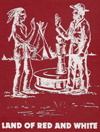 THE REISHUS STORY
THE REISHUS STORY
by Harriet Reishus
Raymond Reishus came to Heinsburg in the early summer of 1932 to take over the position of grain buyer for the Federal Grain Company and the oil agency for the British American Oil Company. Late that same summer Morley Neil arrived to open a garage and filling station. Raymond and Morley batched in the office of Federal Grain.
On August 9th, 1933 Raymond was married to Harriet MacKay of Kitscoty. With the assistance of Mr. Ramsbottom of Lindbergh, he built a small home on a piece of land rented from Mr. Montgomery, Mrs. Rudolph Gregor's step-father. This home was located on the west side of the road just north of the railroad crossing. About ten feet south of the Reishus home was a house occupied by Mr. and Mrs. Ridewood, Mr. Ridewood being employed as section hand under Mr. Prill, the section foreman. Raymond, being a lover of flowers, made the front yard beautiful with a bed of 140 gladioli together with other flowers.
About two years later Mr. Gib Evans, ferryman, and Raymond purchased the parcel of land across from the elevators. The Reishus home was moved to its new location using a stump puller. Mr. MacKay, Harriet's father, helped Raymond do the job, which took about two days. The only piece of furniture removed from the house for the move was the piano which was stored in the garage. The legs were taken out from under the cook stove. After the house was set on its new foundation a porch was built across the back by Raymond, working in his spare time.
Days in Heinsburg were very pleasant and the Reishus' spent many enjoyable evenings fishing for perch and jack- fish in Whitney Lake. A row boat was rented for 504 an evening from Mr. Fraser, the owner of the land and beach. The fish were cleaned at the lakeside on a cleaning board provided by Mr. Fraser. During the summer most Sundays saw many people at Laurier Lake and Whitney Lake to enjoy the beaches, water and fellowship. Many pick-up ball games were played, creating great excitement. In summer fires along the trails to the lakes were prevalent. No one seemed afraid to drive through these. Treaty days at Frog Lake were very glamorous. Some of the merchants in Heinsburg set up stands selling chocolate bars, gum, ice-cream, cigarettes, yard goods, footwear etc. to the gathering. Our native people put on a grand show. Their belief was to dance until it rained. Tents pitched by the natives for housing made a complete Indian village. Everything they owned was there.
Skating on the Saskatchewan River was a winter pastime. Some of the families that I remember who participated in this sport were: Evans, Chartier, Gregor, McMullen, Lawrence, Neil and Kjenner. Hockey was a good game even then. We practised on our river rink. We played games against Landonville who had an elaborate rink, for those days, in Stanley's yard. Much enjoyment was had by participants and spectators. At one of our games the Heinsburg community undertook to serve a hot meal in the hall to all of our Landonville friends. It was a huge success, both crowd and food wise.
One Christmas we spent at my home south of Kitscoty. No roads were snow plowed in those days. We were snowbound and had to return by team and bobsleigh. Two huge rocks were heated on top of Mother's cook stove. These were wrapped in newspaper and served for heat. A tarpaulin was erected over the top of the sleigh box. It was 50 degrees F. below when we left the MacKay home in early morning. Being so cold one couldn't run the horses for fear the cold air would burn their lungs, so they walked all the way to Heinsburg, pulling us. We stopped in Marwayne to rest and feed the team and have dinner at the Marwayne hotel. We arrived in Heinsburg about 10 p.m., temperature 70 degrees F. below zero. The team was unharnessed, blanketed and comfortably stabled in Mr. Jack McMullen's livery barn. Vernon, Harriet's brother, rested the team for a few days before making the return journey.
Late one November an epidemic of scarlet fever struck our little hamlet. Dr. Miller from Elk Point came down and clapped a quarantine sign on our door, McMullen's and a few others. My sister, Dorothy, who was taking her grade ten at the Heinsburg school, was the patient. That afternoon when Raymond returned from work he found he could not enter so he had to move to the elevator office and batch until the quarantine was lifted on December 31. That day the walls and woodwork had to be washed with a lysol solution and a number of pounds of sulphur burned to fumigate the house for scarlet fever germs. That Christmas Day Raymond spent with the Fritz Kjenner family.


